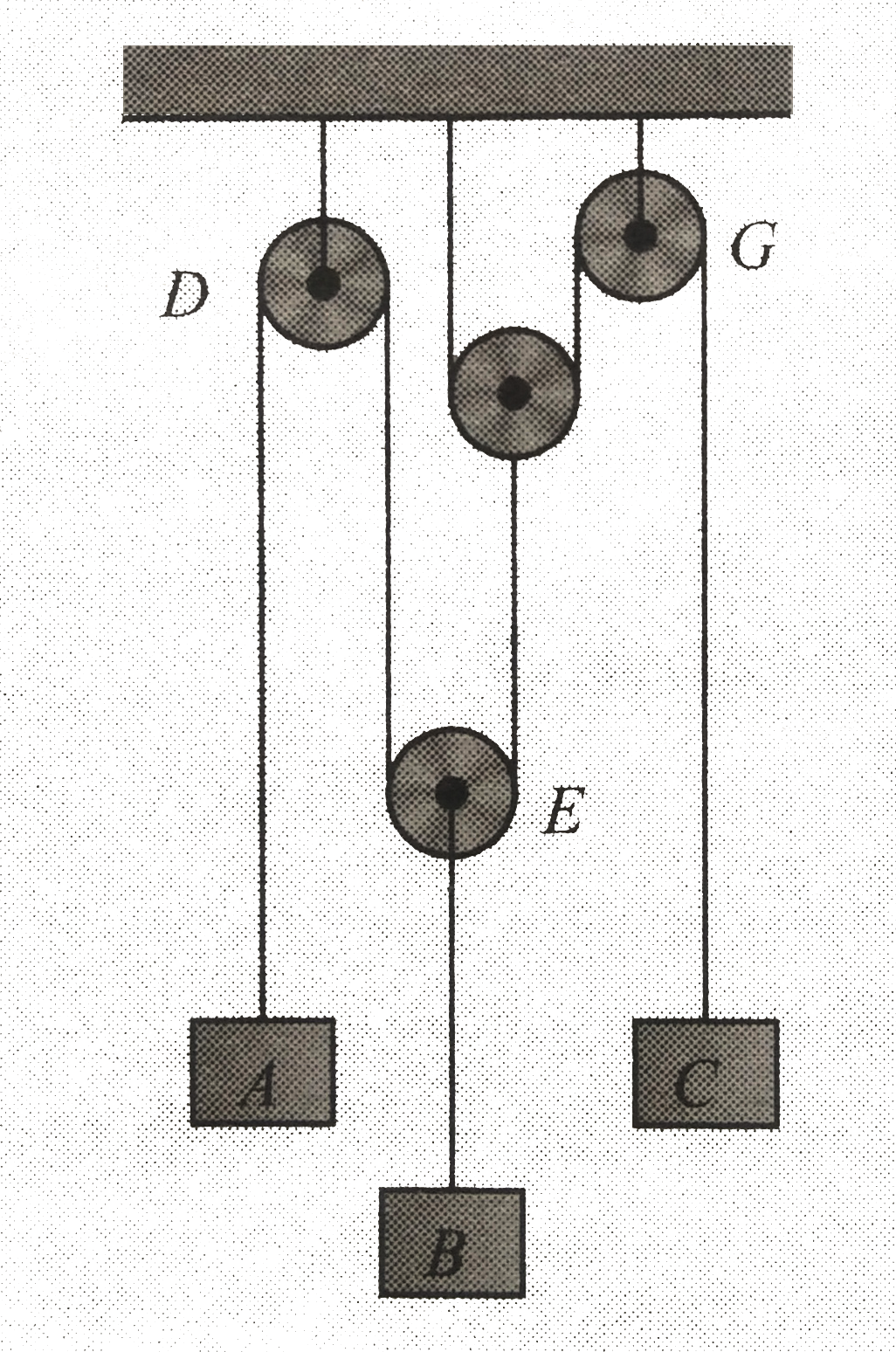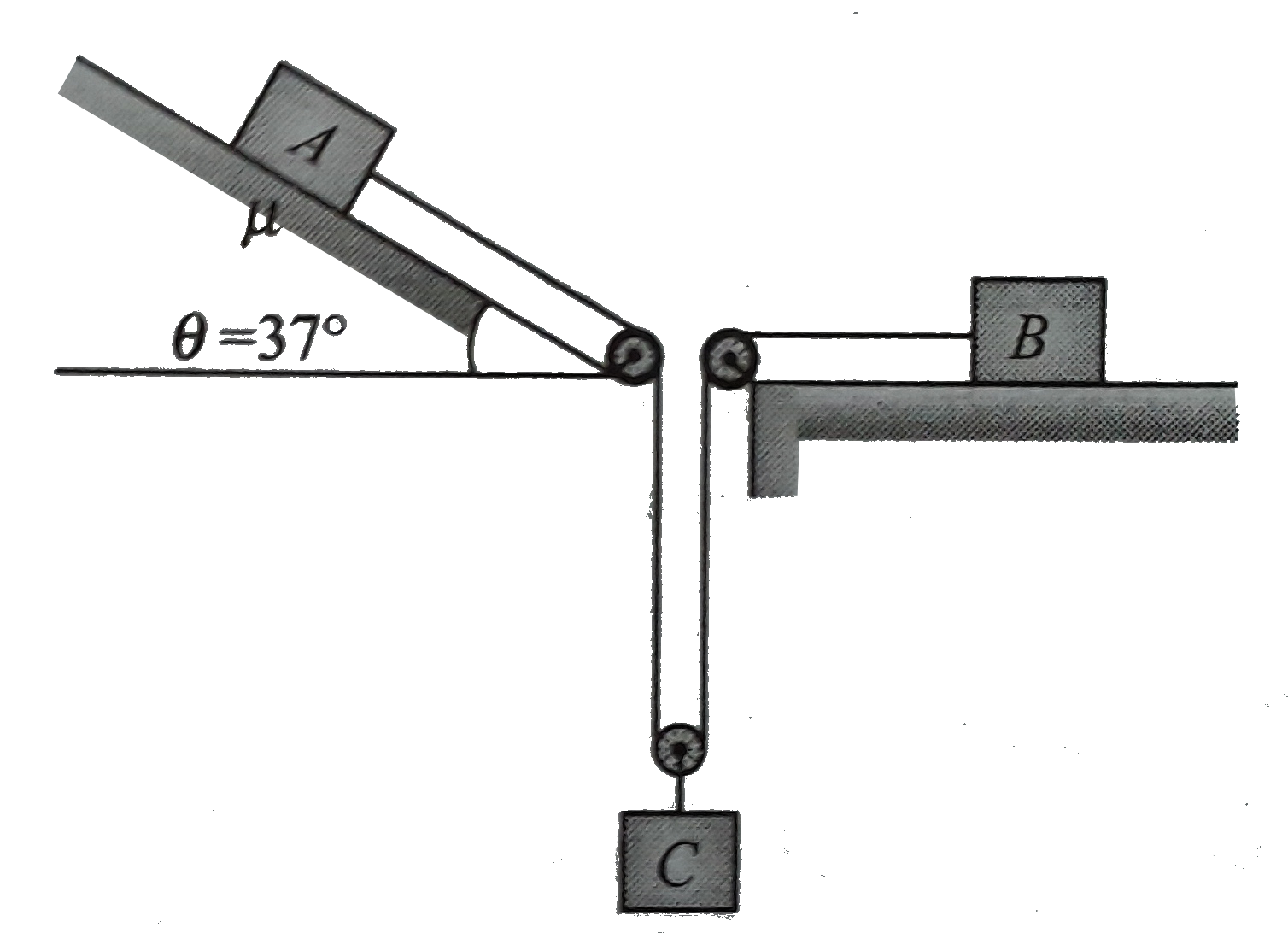Pulleys shown in the system are massless and fricionless. Threads are inextensible. The mass of blocks A, B, and C are m1=2kg,m2=4kg, and (m3)=2.75kg, respectively. Calculate the acceleration of each block.

Let the acceleration of blocks A and B be a and b vertically upwards, and acceleration of block C is c downwards, respectively,

As length of strings are constant. The sum of change in segment length should be zero.
For string 1: [writing from left to right]
(−xA)+(−xB)+(xP−xB)=0
xP=xA+2xB...(i)
For string 2: (−xP)+(−xP)+(xc)=0
xC=2xP ..(ii)
form (i) and (ii) : xC=2xA+4xB
⇒c=2a+4b ...(iii)
Now considering FBDs, we get the following :

For block A, T1−m1g=m1a ...(i)
For block B, 2T1−m2g=m2b ..(ii)
For pulley F, T1=2T2 ...(iii)
For block C, m3g−T2=m3(2a+4b) ...(iv)
Solving above equations,
T1=22N,T2=11N
a=1ms−2,b=1ms−2
Hence, acceleration of block A,
a=1ms−2(↑⏐)
Acceleration of block B,
b=1ms−2(↑⏐)
Acceleration of block C=(2a+4b)=6ms−2(⏐↓).
Topper's Solved these Questions
- NEWTON'S LAWS OF MOTION 1BOOK - CENGAGE PHYSICS ENGLISHCHAPTER - NEWTON'S LAWS OF MOTION 1EXERCISE - Exercise 6.1
11 Videos
- NEWTON'S LAWS OF MOTION 1BOOK - CENGAGE PHYSICS ENGLISHCHAPTER - NEWTON'S LAWS OF MOTION 1EXERCISE - Exercise 6.2
35 Videos
- NEWTON'S LAWS OF MOTION 1BOOK - CENGAGE PHYSICS ENGLISHCHAPTER - NEWTON'S LAWS OF MOTION 1EXERCISE - Integer
5 Videos
- MISCELLANEOUS VOLUME 2BOOK - CENGAGE PHYSICS ENGLISHCHAPTER - MISCELLANEOUS VOLUME 2EXERCISE - INTEGER_TYPE
10 Videos
- NEWTON'S LAWS OF MOTION 2BOOK - CENGAGE PHYSICS ENGLISHCHAPTER - NEWTON'S LAWS OF MOTION 2EXERCISE - Integer type
1 Videos
Similar Questions
Pulleys shown in the system of the figure are massless and friction less. Threads are inextensible. Mass of block A, B and C are m1kg,m2=4kg and m3=2.75kg, respectively .Calculate acceleration of A block

View SolutionIn the arrangement shown in the figure pulleys are small, light and frictionless, threads are inextensible and mass of blocks A, B and C is m1=5kg, m2=4kg and m3=2.5kg respectively and co-efficient of friction for both the planes is μ=0.50. Calculate the acceleration of block A (in m/s2) when the system is released from rest. (g=10m/s2)

View Solution
Knowledge Check
If m1=10kg,m2=4kg,m3=2kg, the acceleration of system is
 A5g/2B5g/3C5g/8D5g/14
A5g/2B5g/3C5g/8D5g/14If m1=10kg,m2=4kg,m3=2kg, the acceleration of system is
 .A5g/2B5g/3C5g/8D5g/14
.A5g/2B5g/3C5g/8D5g/14If pulleys shown in the diagram are smooth and massless and a1 and a2 are acceleration of blocks of mass 4 kg and 8 kg respectively, then -
 Aa1=a2Ba1=2a2C2a1=2a2Da1=4a2
Aa1=a2Ba1=2a2C2a1=2a2Da1=4a2
In the arrangement , shown below pulleys are massless and frictionless and threads are inextensible , block of mass m1 will remain at rest if

View SolutionIn the arrangement , shown below pulleys are massless and frictionless and threads are inextensible , block of mass m1 will remain at rest if

View SolutionIn the arrangement shown in figure pulleys are mass of block A,b and C is m1=5kgm2=4kg and m3=2.5kg respectively .Co-efficient acceleration of friction for both the plane is μ=0.50 Calculate acceleration of which block when system is released from rest

View SolutionIn the arrangement shown in figure pulleys are mass of block A,b and C is m1=5kgm2=4kg and m3=2.5kg respectively .Co-efficient acceleration of friction for both the plane is μ=0.50 Calculate acceleration of which block when system is released from rest

View SolutionPulleys are ideal and string are massless. The masses of blocks are m1=4kg and m2=1kg as shown.If all surfaces are smooth then the acceleration of m2 in m/s2 is (g=10m/s2 )

View Solution
